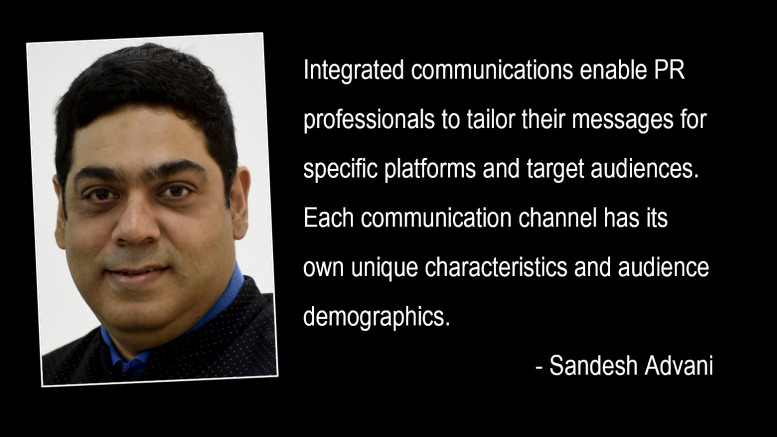Effective communication is vital in shaping public perception and managing reputations in today’s fast-paced digital world. Public relations (PR) professionals constantly adapt to new technologies and strategies to ensure their messages reach the right audiences. One such approach is integrated communications, which combines various channels and disciplines to create a unified and consistent brand image. While integrated communications offer numerous advantages, they also present challenges for PR professionals. This article explores the benefits and drawbacks of integrated communications and its impact on PR professionals.
Integrated communications involve seamlessly integrating multiple communication channels, such as advertising, public relations, social media, and marketing. This approach aims to create a cohesive and consistent brand message across all platforms, maximising the impact of communication strategy. By integrating various channels, PR professionals can reach a broader audience and create a unified brand experience. This comprehensive approach allows organisations to build stronger stakeholder relationships, enhance brand loyalty, and effectively manage their reputation.
One of the key advantages of integrated communications is its ability to amplify the reach of PR campaigns. By leveraging multiple channels, PR professionals can connect with audiences across different touchpoints. For example, a well-crafted press release can be distributed through traditional media channels while simultaneously being shared on social media platforms and published on the organisation’s website. This multi-channel approach ensures that the message reaches a wider audience and increases the likelihood of being noticed and shared.
Moreover, integrated communications enable PR professionals to tailor their messages for specific platforms and target audiences. Each communication channel has its own unique characteristics and audience demographics. By understanding these nuances, PR professionals can effectively adapt their messages to resonate with each platform’s users. For instance, a PR campaign may utilise visually engaging content on social media platforms like Instagram while focusing on a more formal tone for press releases and media relations. This customisation enhances the overall effectiveness of the communication strategy.
Additionally, integrated communications can help PR professionals build a consistent brand image. Organisations can convey a unified identity and brand promise by aligning messaging across different channels. This consistency enhances brand recognition and helps establish trust with stakeholders. When PR professionals maintain a consistent narrative and tone of voice across various touchpoints, it reinforces the organisation’s credibility and strengthens its reputation.
However, integrated communications also present challenges for PR professionals despite its benefits. One of the main hurdles is the complexity of managing multiple channels and coordinating diverse communication activities. Integrated communications require PR professionals to understand various platforms and disciplines, such as advertising, social media, and content creation. It demands a high level of coordination and collaboration between different teams, which can be challenging to achieve, especially in larger organisations.
Another challenge is the risk of information overload. In today’s digital age, audiences are constantly bombarded with information from various sources. PR professionals must find a way to cut through the noise and capture the attention of their target audience. With integrated communications, there is a risk of overwhelming audiences with redundant or conflicting messages across different channels. PR professionals must carefully craft communication strategies to ensure consistency and avoid overwhelming their audience. Research has shown that nearly two in five (39 per cent) respondents said they have to use 11 or more accounts, resources, tools and apps daily. This compares with just one in five (21 per cent) who said this was the case two years ago, proving that the information people need to access resides within an increasing number of data repositories and applications. In fact, due to the siloed nature of where information sits within organisations, three in five Indian employees (58 per cent) said that they normally spend, on average, one or more hours per day searching on company networks or shared systems for specific work files or pieces of information to do their job.
Moreover, integrated communications require PR professionals to stay updated with the ever-evolving landscape of communication technologies and trends. New social media platforms emerge, algorithms change, and consumer behaviours evolve. PR professionals must continuously adapt and learn to leverage the latest tools and techniques to engage with their target audience effectively. This constant need for learning and adaptation can be demanding and time-consuming for PR professionals.
In conclusion, integrated communications offer both advantages and challenges for PR professionals. The ability to amplify reach, customise messaging, and build a consistent brand image makes it a practical approach for effective communication. However, the complexity of managing multiple channels, the risk of information overload, and the need for continuous adaptation pose significant challenges. PR professionals can harness integrated communications’ benefits in their campaigns by fostering strong cross-functional collaboration, deeply understanding their target audience, and continuously adapting to the changing communication landscape.
The views and opinions published here belong to the author and do not necessarily reflect the views and opinions of the publisher.



Be the first to comment on "Integrated Communications: A Boon or a Bane for PR Professionals?"